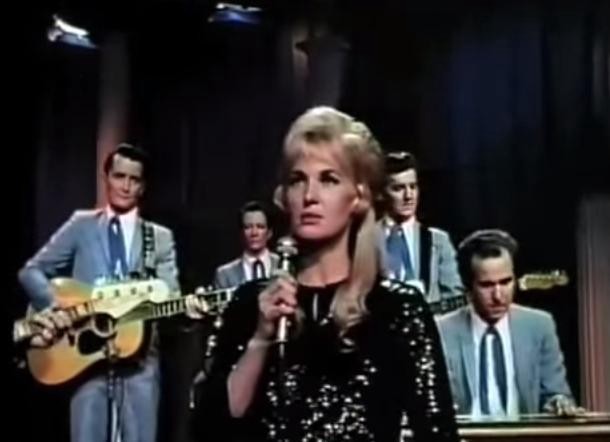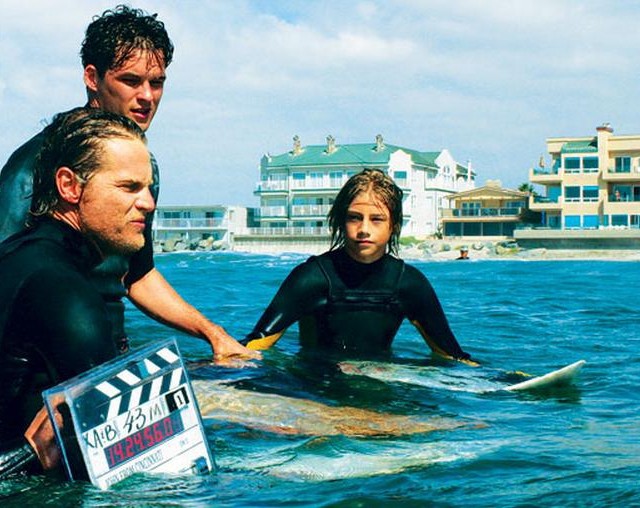Rambos Among Us
There are a number of perfectly reasonable reasons to be concerned about the growing militarization of domestic U.S. police departments, which increasingly rely on military tactics, equipment and former personnel in the course of their day-to-day policing. Nearly as disconcerting is their rationale for doing so, John Rambo:
In the Indianapolis suburbs, officers said they needed a mine-resistant vehicle to protect against a possible attack by veterans returning from war.
“You have a lot of people who are coming out of the military that have the ability and knowledge to build I.E.D.’s and to defeat law enforcement techniques,” Sgt. Dan Downing of the Morgan County Sheriff’s Department told the local Fox affiliate, referring to improvised explosive devices, or homemade bombs.
One hopes that Brian Dennehy has taken every possible precaution.
SLK, "Pour"
Siri, play me a song that sounds like the rain outside — actually, no, Siri, play me a song that sounds like wet shoes and cheap umbrellas. Wait, Siri: Play me a song that sounds like a cold damp head and an enormous cup of coffee. Siri wake up. SIRI. (Via)
Withdrawals Made
“Perhaps it’s time for acceptance: Yes, the banks have used our weakness against us, and they have won.” — This story, ostensibly about the insane proliferation of bank branches around New York City, turns out to be about quite a bit more.
Death to Negronis

An aperitif is a bitterish alcoholic beverage that was originally meant to be served before a meal to stimulate the appetite because people in the nineteenth century believed all sorts of wonderful things about alcohol, which they had to drink constantly because water, prior to modern sanitation, was a biohazard. Also it’s sort of weird to think that you needed to drink alcohol to become hungry since basically everyone was starving all the time back then.
Anyway, one aperitif is called the negroni. It is a cocktail that is made, typically, with one part gin (a neutral spirit not unlike vodka, but with plant stuff, most commonly and notably, juniper berries); one part sweet vermouth (a fortified wine with plant stuff); and one part Campari (a pinkish, bitter liqueur…with plant stuff). A million, literally a million, articles have recounted the negroni’s origins, usually by stating “so the story goes” or “so the tale goes,” before going on to recall that it was named for Count Negroni, a man who preferred gin to soda because he was in fact a monster. The negroni was relatively obscure in America until the mid-aughts or so; a Times piece in 2002 described it as “a relative stranger on these shores,” but for San Francisco, which was “the stronghold of the drink in this country.” Its popularity grew slowly, until circa 2010–2012, when everybody who intensely talks about things like beverages lost their collective shit over it. (The numbers support this teleology: Campari, the linchpin of the drink and most of variations, saw sales rise just four per cent from 2009 to 2010, but then sixteen per cent year over year from 2010 to 2011, followed by twelve per cent growth the following two years. This is likely driven by negronis, rather than the more refreshing Americano.)
When made properly — not too heavy on the gin, not with shitty vermouth and without telling anyone next to you how great it is — the negroni is perfectly fine. It has, itself, committed no sins. However, if you were to put everybody who is dying to tell you how much they like negronis into a bar, it would be the single largest and worst bar in the world, a sticky cesspool of people, standing should to shoulder, talking animatedly about nothing except how wonderfully the negroni balances its floral, herbal notes with bitterness and sweetness; how they can’t believe that other people don’t love them as much as they do, what is wrong with their palate; how they had the best negroni of their life at some bar you’ve never been to, or in Italy (which is a steadfast lie, because no one in Italy knows how to make cocktails); how their own slightly tweaked proportion of clear liquor to sweet wine-liquor to bitter pink liquor is in fact the best of all possible negroni variations, and while the negroni spinoffs like the far sturdier boulevardier, with a backbone of whiskey, are fine, the true negroni is better and able to be enjoyed at all times of day, but most especially during negroni season, which is a lie and doesn’t make any sense because if it’s actually really hot you should probably be drinking beer or seltzer with a lime, not a syrupy concoction all too often served up, rather than on the rocks.
The subtext of the discussion at this mythical world’s-most-awful bar, which might actually exist on the Internet, is that anyone who enjoy negronis has an incredibly distinguished palate which allows them to fully enjoy negronis in a way that most people can’t appreciate. One person told the Times that the negroni is “a sophisticated cocktail, too, for an audience that appreciates the cocktail and the story behind it.” Bon Appetit described the negroni at one point as “a secret handshake, a sign to bartenders that you knew what you liked, and how to order it.” Serious Eats calls it “a serious drink for serious drinkers.” GQ says, “A Negroni, like black coffee or Texas, is an acquired taste.”
This notion hinges on the negroni’s purported bitterness and botanicals, and the way it balances these flavors. But one third of its profile is sweet vermouth, like Carpano Antica — this, by the way, is when a negroni drinker will pop up and offer their own preferred vermouth, such as Punt e Mes or Cocchi Vermouth di Torino, particularly since there is a slight Carpano Antica backlash that seems to be brewing given its ubiquity in cocktail establishments — which is thick and rich and powerful and sweet. The negroni, in other words, is a generally sweet cocktail for people who wants to say that they enjoy the bitter things in life, a loud clamoring brought upon in part by the Great American Palate Shift, which venerates bitterness as way to celebrate the superiority of its proponents vis-a-vis their conquest of both evolutionary biology (our inherent primate brains associate bitterness with poison) and mainstream American taste (which demands only salt, fat and sugar).
As the primary medium by which Campari makes its way down the gullet of Americans who believe themselves to be tastemakers, Campari, the company, cares deeply about the ongoing success of the Negroni (look at those sales!). It has even succeeded, in partnership with Imbibe, in making #NegroniWeek a real thing that is currently taking place. Participating bars around the country are donating one or two dollars from each negroni sale to a charity of their choice. (Which, before I proceed, all donations to local charities, whatever the reason, are of course inherently good. BUT.) Campari is promising to give ten thousand dollars to the charity of the bar that raises the most money by selling the most negronis. A case of twelve bottles of Campari goes for three hundred and forty dollars at Astor Wine & Spirits (though obviously bars pay less than this). It is expecting more than eleven hundred bars to participate, raising at least one hundred thousand dollars, making for roughly ninety thousand negronis. That’s a lot of Campari. For this, the company is giving just ten thousand dollars to charity.
The negroni cannot support the weight of a cause, much less an entire belief system, despite everything that its adherents have poured into it. It’s a drink. A drinkable one. I guess. Sometimes. Drink it if you want. Or drink a beer. Or literally anything else. Just don’t tell anybody about it.
“Carbonated negroni” photo by Bart Everson.
New York City, June 5, 2014

★★★★ The morning was well short of full daylight; rain poured out the gray-brown dimness. The elementary school was closed for the day and the prospect of getting the preschooler off to preschool with the first-grader in tow seemed if not impossible at least pointless, or too difficult. Things stalled out, the breakfasts not quite finished, the clothes pulled out but not yet replacing the pajamas. To turn the kettle back on and follow up the first cup of tea would amount to surrender. Weren’t the showers almost past? A radar map showed them going by, but time was going by too. The children made it down the elevator and a step or two out the door, at which point it became clear that further progress would require going back up to fetch a brace of umbrellas. The going-back-up part happened, anyway. Across the avenue, a worker swept water off the open slab of the new tower’s top floor. Each stroke sent a sold-looking mass of water over the edge, where it blew south and broke into droplets and vanished within the first five stories of the drop. The rain was over, but the dripping carried on heavily. Water splashed down through the grate onto the subway tracks. The landing on the stairs up out of the station downtown was sheeted with water, held by a clogged drain. And then, in the time it took to eat a long lunch, the story changed utterly. A brightening outside the restaurant windows revealed itself to be a hazeless sky with pristine white clouds sailing across it on a drying breeze. The sky over Houston Street was vast and open. The moon was ascending, its curve tilted just a little away from straight up. Garbage was coming unstuck from the pavement, matchstick and bottle cap separating themselves from the ground with a sharp slice of shadow. Putting on sunscreen in the gray morning had felt like superstition, now justified. A line of literary aficionados stretched around the corner and down the block from the bookstore. On Broadway, the building facades framed a space of immense luminous white volumes, shaded with gray, on a scale that made the streetscape look like an assemblage of paper cutouts. A beam of light slipped under the apartment door and ascended to somewhere above knee-high on the far wall of the hallway. The western clouds were purple and skinny, and for a moment the sunset traced a bright pink-gold line along the leading edge of each one.
What to Say to a Man in a Short-Suit

♫ Shorts, shorts, shorts, short shorts ♫:
At this summer’s weddings and white parties, the nattiest gentlemen will be wearing shorts with a corresponding suit coat. At least, that’s what J.Crew would have you believe, along with a few other menswear companies that are giving the look a hard sell this season…
From all perspectives, the short-suit is an odd pairing. Sartorially, the look is equal parts business and schoolboy. Functionally, it’s both breezy and stifling, and socks are a no-no, unless they go up to one’s knees. The list of people who can pull it off doesn’t stretch much beyond professionals in Bermuda and street-style icons such as Nick Wooster and Pharrell.
A minor problem with this, one maybe not apparent from the design studios and agency meeting rooms of New York, is that a crude variation of this style is already popular, particularly in the easternmost regions of the Southern Frat Belt (one of at least four belts and one midwestern quadrilateral zone). Just loosen the fit and add either neon Wayfarers or an Oakley/Croakies combo. Put a red cup in the hand. Bad look. Death. If you look like a model, and your short-suit fits perfectly, maybe you can pull this off. If you carry yourself like anything BUT a model, your best possible outcome is looking sort of like Angus Young.
There is also the moral dimension, but it is complicated.
What often comes to mind when I see things like this is an image of an older man, who is one part my dearly departed grandfather and one part everyone else’s, politely declining to comment on his grandson’s outfit. This grandson remembers his grandfather’s story about the first suit he bought as an adult, during the Great Depression, with paychecks from the slaughterhouse where he swept blood after hours. He kept it for years, and its legs were ironed, straight, and full.
But when grandfather gently changes the subject, he wants to talk about time, about all the things he doesn’t know and never will, and how what he is most proud of, after the times he stood up for helpless people, is how he tried never to get in the way of the young ones with energy — not the zealous wide-eyed monsters, but the few who somehow knew, intuitively, how to assert themselves with candor and humility. The children are the future, and the preternaturally wise are their corrective. Change is good.
Then I still think he would ask, eventually: Can you please change?
Standing by Your Man
by Casey N. Cep

The year was 1968. In May, Wynette sang courageously about the heartbreak of “D-I-V-O-R-C-E.” Then, in September, she offered the heart-aching advice to “Stand By Your Man.” Both songs topped the charts, but she’s remembered mostly for the staying, and not for the going — which is odd, since Wynette divorced five different husbands.
It’s odder still since “Stand By Your Man” is not so much revered as reviled. Women are accused of standing by their men, not applauded for it. Political wives are almost always judged by this standard, at least since 1992, when Hillary Clinton invoked the song during an interview with 60 Minutes. She and her husband, then the governor of Arkansas, were being interviewed by Steve Kroft; after a few minutes of Jesuitical questions about paramours and press statements, he said, “Most Americans would agree that it’s very admirable that you have stayed together — that you worked your problems out and that you seem to have reached some sort of an understanding — an arrangement.”
President Clinton interrupted to say, “Wait a minute, wait a minute, wait a minute. You’re looking at two people who love each other. This is not an arrangement or an understanding. It’s a marriage, and that’s a very different thing.”
Secretary Clinton interrupted her husband to clarify: “You know I’m not sitting here as some little woman standing by my man like Tammy Wynette. I’m sitting here because I love him, and I respect him, and I honor what he’s been through and what we’ve been through together. And you know, if that’s not enough for people, then heck: don’t vote for him.”
Hillary is Loretta Lynn, not Tammy Wynette: more “Fist City” (“I’m not a sayin’ my baby’s a saint ’cause he ain’t and that he won’t cat around with a kitty”) than “Stand By Your Man.” Because of what Hillary said that night, practically every wife, during every political scandal, has been asked if she’ll stand by her man, and then, finally, described as having stood by said man. The song is invoked, not as a praiseworthy paean to marital fidelity, but as a political punchline: Will she stay or will she go?
It’s an unfortunate fate for a beautiful song. Wynette always said she wrote it in fifteen minutes, but lyrically it’s a song that took a lifetime to write. “Sometimes it’s hard to be a woman,” Wynette croons at the start, which it is, no matter the men or women you’ve been with before, or that you’re with now. The song deeply sympathizes both with how hard it is to be a woman and how difficult it is to be with someone. “You’ll have bad times,” she sings, “and he’ll have good times, doin’ things that you don’t understand.”
That, of course, is the truth: Partners will fail you. They’ll eat peanut butter from the jar; they’ll spend more money than you have; they’ll want children before you do; they’ll dislike your family or your friends. Relationships of any kind are difficult. They are also almost entirely impenetrable to those outside them. It’s a beautiful mystery why some relationships last, and a confusing tragedy why others do not. Who stays and who goes is rarely understood by those on the outside, since it is not always understood by those on the inside.
That is why Wynette’s song is so beautiful. Not because you should always stay, but you should try to stay. Wynette says “keep giving all the love you can,” which intimates that there are limits to love — that you might give all that you can, but even that will not be enough. And if it isn’t, then you “D-I-V-O-R-C-E.” That song, though her manager expected it to be the one that defined her career, is mostly forgotten. It’s melodramatic, but so is every divorce.
“Our little boy is four years old,” Wynette begins, “So we spell out the words we don’t want him to understand.” Spelling songs were nothing new (Aretha Franklin had released “Respect” in 1967), but this one spelled joyful words like toy, surprise, and the boy’s name in juxtaposition with sorrowful words like divorce, custody, and hell. “The words we’re hiding from him now,” Wynette says, “tear the heart right out of me.”
Twice she sings, “I wish that we could stop this D-I-V-O-R-C-E,” but of course she won’t. It’s like wishing you could stand by your man after you realize you can’t: Wishing doesn’t make it so. And that is, of course, what’s so painful about almost every separation, every divorce of any kind: Even when you feel empowered to go, you have no power to stay. After all, he’s just a man or you’re just a man or she’s just a woman: We’re all just people. A cliche like any other, but like all the others, true.
Tammy Wynette was called the First Lady of Country Music — fitting not only because she was married once to George Jones, but because she occupied a political role in its canon. She didn’t stay, but she sang about trying to, and she didn’t want a divorce, but she sang about getting one.
Casey N. Cep is a writer from the Eastern Shore of Maryland.
The Wikipedian Distinction
“Like any internet community, you draw introverts, and you draw introverts like us who know how to talk to people.”
The Knife, "För alla namn vi inte får använda"
An excerpt, preview, chunk, from an upcoming “political activist cabaret” that The Knife is scoring. The European immigration debate is… not quite like ours!
HBO's Historical Revisionism

Congratulations to Game of Thrones and its infinitely frustrating creator: The show is now the “most popular series in HBO’s history.” That’s an average audience 18.4 million compared to 18.2 for The Sopranos.
Speaking of history! HBO has a strange sense of its own. The network has, for the last ten years, minimized its pre-Sopranos existence as much as possible, full as it was with late night softcore porn and of-the-moment comedy specials. Now, with HBO Go, the company has been given a chance to fully rewrite its story, and it has taken it: The “All Series” section of HBO Go presents what looks and feels like an exhaustive look back at HBO’s original programming history (Little Britain USA is right there next to The Wire). The popular series you’re looking for is probably there. There’s porn and boxing and documentaries and children’s programming. The network’s rotating lineup of movies gets a section, as does HBO Latino.
But “All Series” does not mean “All Series,” or anything close. The further back you go, the thinner things get relative to HBO’s actual catalog, until there’s almost nothing at all (there seems to be an unofficial soft cutoff at about… Oz). This is intuitive enough: Potential viewership for 1st & Ten is low, and rights issues seem like they would be more complicated over time — I mean, I don’t know, if some HBO executive said these things to me I would think, ok, sure, that explains why there’s no Tales From The Crypt on my Apple TV. But a lot of the network’s older shows are genuinely interesting, both as entertainment and as curiosities. I’d love to revisit Tanner ’88, maybe, for an episode or two! (I suppose I can, but only on Hulu Plus or DVD.) I would also like to take a look at Dream On, the show that gave us the ubiquitous HBO static intro. The Larry Sanders Show certainly holds up well: I know because I watched the entire thing on Netflix, from which it has since been removed, and then began watching it again on Amazon before it was removed from that, too. Amazon recently inked a fresh deal with HBO, which seems to mirror HBO Go’s content, but which does not include Larry Sanders. Garry Shandling has been written out of HBO’s past.
And what about Mr. Show? Here’s what its creators said about the show’s exclusion from Go in a q&a; last year:
(Bob here) HBO has a hate-hate relationship with the show.
(Brian here) They are not aware that we did the show.
(David, back) They hate having to google Mr. Show.
A legitimate cult classic! But again, these are shows from the before times, pre-David Chase and prior to cable’s prestige programming rush. It is not unusual for old shows from any network to be sent to the licensing and syndication glue factory for processing and extraction. HBO’s treatment of more recent shows, however, is outright revisionist. Luck, which was available as it was airing on HBO Go, has been removed. There’s no John From Cincinnati (though David Milch can still revisit old episodes of Deadwood, if he wants). Funny or Die Presents has been pulled, as has The Life and Times of Tim. HBO is actively curating Go like some sort of premium cable dating profile: Carnivale wasn’t there and then it was; In Treatment just showed up one day, mysteriously, just like Tell Me You Love Me. Pulled shows exist in HBO Go’s search results, but any attempt to watch them returns an “Unknown Error.”
This is always what happens when data gets vacuumed up into some new app or service, even the ones that imply completeness; Google does not actually “organize the world’s information;” Wikipedia is a great summary of information about the world that was already on the internet; Spotify and iTunes are staggering resources with no deliberate sense of history or context. The Kindle library is arbitrarily selective but purports, or at least feigns, to serve as the be-all, end-all of words on pages.
But HBO can do whatever it wants, all it has to do is digitize and host its own shows. It’s a TV network’s job to figure out what to write out of its future, not what to delete from its past. Give us the bad stuff with the good! HBO, own your turds! They’re better than most of what’s on Netflix, anyway, and I’m getting tired of clicking.
